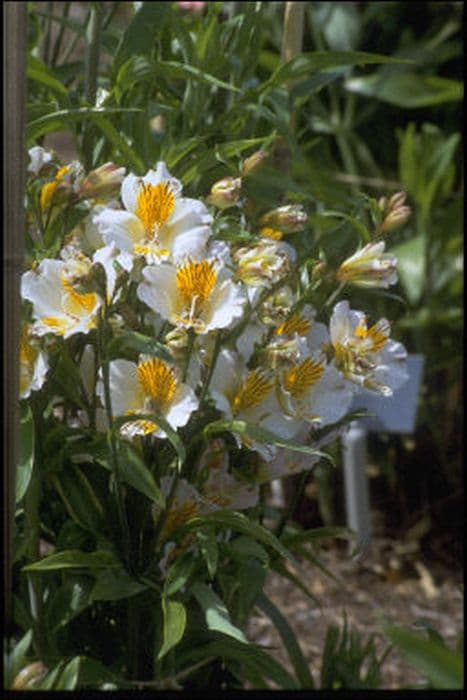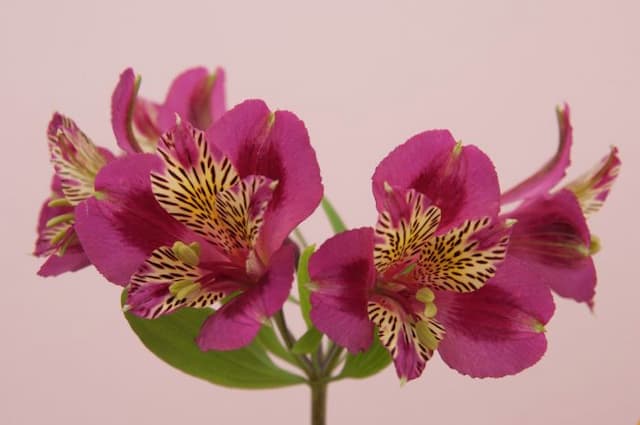Peruvian Lily Alstroemeria Princess Paola = 'Stapripal' (PBR) (Princess Series)
![Peruvian lily [Princess Paola]](/_next/image?url=https%3A%2F%2Fplants-admin.emdemapps.com%2Fimages%2Fplants%2F%2Fimages%2F604b54933e7a3.png&w=3840&q=75)
ABOUT
The Alstroemeria Princess Paola, also known as Peruvian Lily from the Princess Series, is a striking plant with a vibrant display. It features a sumptuous palette of colors; the flowers exhibit a bold blend of golden-yellow petals marked with heavy brushstrokes of a deep burgundy hue, reminiscent of a rich maroon. These petals often flaunt delicate freckles that add to their exotic charm. Each blossom is unique, presenting a slightly different pattern of these intense markings and spots. The blooms are formed in clusters, creating a lush and full appearance that is eye-catching and adds a touch of elegance to any setting. The foliage is also attractive, with lance-shaped leaves that spread out in a dense, verdant arrangement. The leaves have a glossy surface, contributing a lush, green backdrop that complements the bright flowers. The plant exhibits an overall bushy and compact form, contributing to its ornamental appeal. Peruvian Lily is a graceful addition to the garden with its exquisite blooms that can also make outstanding cut flowers, bringing the same splendor indoors. Its blossoming period extends through the warmer months, ensuring a long-lasting display of its remarkable flowers. With its dazzling colors and appealing form, Alstroemeria Princess Paola is a delightful choice for gardeners and floral enthusiasts alike.
About this plant
 Names
NamesFamily
Alstroemeriaceae
Synonyms
Inca Lily, Peruvian Lily, Lily of the Incas
Common names
Alstroemeria 'Stapripal'
 Toxicity
ToxicityTo humans
The Alstroemeria, commonly known as the Peruvian Lily or Lily of the Incas, has a low level of toxicity to humans. Ingesting parts of the plant can potentially lead to mild symptoms, which might include nausea, vomiting, or diarrhea. Most people will not experience severe effects, but allergic reactions are possible, particularly from handling the plant and getting the sap on the skin, which can cause dermatitis in sensitive individuals. It is typically not considered highly toxic, but it is still advisable to handle the plant with care and avoid ingesting it to prevent any potential discomfort or adverse reactions.
To pets
The Peruvian Lily is considered to have a low level of toxicity to pets as well. If a pet ingests parts of this plant, they might experience mild gastrointestinal upset, which could manifest as symptoms like vomiting or diarrhea. There is also a risk of an allergic reaction, especially for pets with sensitive skin that might come into contact with the plant's sap. Although not acutely toxic, it is recommended to keep the Peruvian Lily away from pets to avoid any potential health issues that could arise from ingestion.
 Characteristics
CharacteristicsLife cycle
Perennials
Foliage type
Semi-deciduous
Color of leaves
Green
Flower color
Mixed
Height
1-2 feet (30-60 cm)
Spread
1-2 feet (30-60 cm)
Plant type
Herb
Hardiness zones
7
Native area
South America
Benefits
 General Benefits
General Benefits- Long blooming period: The plant often blooms from late spring through early fall, providing a long-lasting display of color.
- Attractive flowers: It offers showy and vibrant flowers, which are great for enhancing the visual appeal of gardens and landscapes.
- Good cut flowers: The blooms have a long vase life, making them excellent for use in floral arrangements.
- Drought tolerance: Once established, it has a good level of drought resistance, minimizing the need for frequent watering.
- Low maintenance: Requires minimal care beyond initial establishment, making it a good choice for gardeners of all skill levels.
- Cold hardiness: It can survive in relatively cold climates, down to USDA zone 7, making it suitable for many temperate gardens.
 Medical Properties
Medical PropertiesThis plant is not used for medical purposes.
 Air-purifying Qualities
Air-purifying QualitiesThis plant is not specifically known for air purifying qualities.
 Other Uses
Other Uses- Crafts and jewelry: The intricate patterns and bright colors of the Alstroemeria flowers can be replicated in designs for fabric, earrings, and even necklace pendants for a floral-themed fashion statement.
- Photography subject: With their unique beauty, Alstroemeria flowers are often used by photographers as subjects for botanical photography and photo compositions.
- Edible cake decorations: The petals of Alstroemeria can be crystallized with sugar and used as beautiful, natural decorations on cakes and desserts.
- Artistic inspiration: Artists may use Alstroemeria flowers as a muse for paintings, drawings, and even sculptures, capturing their form and color.
- Color dye source: The pigments from the Alstroemeria petals can be used to create natural dyes for fabrics or art projects.
- Table setting theme: Alstroemeria flowers can be used to create a cohesive color theme or atmosphere when setting a table for a special event or a romantic dinner.
- Learning tool for botany: These plants can be used in educational settings to teach students about plant biology, hybridization, and the growth patterns of perennial plants.
- Garden design: Alstroemeria can serve as inspiration for garden themes, especially when aiming for a landscape that blooms with vivid colors throughout the season.
- Companion planting: The Alstroemeria can be planted amongst vegetables and herbs to create an attractive and beneficial garden environment, although its direct benefits are not well-documented.
- Symbolic gift: The flowers are often associated with friendship and devotion, making them a thoughtful and symbolic gift for friends or loved ones on special occasions.
Interesting Facts
 Feng Shui
Feng ShuiThe Peruvian lily is not used in Feng Shui practice.
 Zodiac Sign Compitability
Zodiac Sign CompitabilityThe Peruvian lily is not used in astrology practice.
 Plant Symbolism
Plant Symbolism- Friendship: Alstroemerias, also known as Peruvian Lilies or Lily of the Incas, often symbolize enduring friendships, reflecting the plant's long-lasting nature as a cut flower.
- Wealth, Prosperity and Fortune: With their vibrant colors and full blooms, they represent the idea of wealth and prosperity, making them a common gift to wish someone good fortune.
- Devotion: The twisted leaves of the plant indicate the trials and tribulations of friendships, suggesting a sense of devotion and mutual support through challenging times.
- Achievement: The lush and attractive flowers are often seen as an emblem of personal achievement and the beauty that comes with reaching one's goals.
- Strength and Determination: As a hardy plant, it can symbolize the strength and determination of a person, representing the ability to persist through challenges.
 Water
WaterPeruvian lilies should be watered regularly to maintain moist but not soggy soil, particularly during the growing season. Water them deeply once a week, providing about an inch of water each time or roughly half a gallon per square foot of soil area. Cut back on watering in the fall and winter when the plant is not actively growing.
 Light
LightPeruvian lilies thrive in a spot with full sun to partial shade. They perform best when they receive at least six hours of morning sunlight and some afternoon shade, especially in the hotter regions to prevent the foliage from scorching.
 Temperature
TemperaturePeruvian lilies are hardy in a range of temperatures but prefer an ideal growing temperature between 65°F and 75°F. They can generally survive in temperatures as low as 23°F and as high as 80°F without suffering serious damage.
 Pruning
PruningPrune Peruvian lilies to remove dead or faded flowers, which encourages more blooms. It's best to pull the stem from the base rather than cutting to promote healthy regrowth. Pruning should be done throughout the growing season as flowers fade.
 Cleaning
CleaningAs needed
 Soil
SoilFor the Peruvian Lily, the best soil mix is a well-draining, fertile loam with a high content of organic matter. A mix of two parts garden soil, one part peat or compost, and one part perlite or sand works well. The ideal soil pH for this plant should range between 6.5 and 7.0.
 Repotting
RepottingPeruvian Lilies should be repotted every two to three years to replenish soil nutrients and to accommodate root growth. They should be repotted in the spring before they start their active growth cycle.
 Humidity & Misting
Humidity & MistingThe Peruvian Lily thrives in moderate to high humidity conditions. Ideal humidity levels range from 40% to 60%. Avoid placing plants in overly dry environments.
 Suitable locations
Suitable locationsIndoor
Place in bright, indirect light and keep soil moist.
Outdoor
Full sun to partial shade in fertile, well-draining soil.
Hardiness zone
7-10 USDA
 Life cycle
Life cycleAlstroemeria Princess Paola, commonly known as Peruvian Lily, begins its life cycle as a rhizome planted in well-drained soil. After planting, it undergoes a period of germination where shoots emerge and develop into foliage. This is followed by the vegetative growth stage where the plant grows leaves and stems, maximizing photosynthesis and preparing for reproduction. It then enters the flowering stage during late spring to summer, showcasing vibrant blooms that are often used in cut flower arrangements. After pollination, the plant may produce seeds, but it more commonly propagates through division of rhizomes. As temperatures drop in autumn, the Peruvian Lily enters a dormancy period, saving energy for the next growing season.
 Propogation
PropogationPropogation time
Spring-Early Summer
Alstroemeria Princess Paola, commonly known as the Peruvian Lily, can typically be propagated through division, which is the most popular method for this plant. The best time for dividing Peruvian Lilies is in the early spring or late fall when the plant is not in active growth. To propagate by division, carefully lift the clump of tubers from the ground using a garden fork, being mindful not to damage the tubers. Once lifted, gently pull or cut the tubers apart, ensuring that each section has at least one growth point or "eye." Replant the divisions at a depth of approximately 6 to 8 inches (15 to 20 centimeters), spacing them about 12 to 18 inches (30 to 46 centimeters) apart to give them room to grow. Water in the new divisions well to help establish them. This method encourages a rapid return to flowering and helps maintain the vigor of the plants.





![Peruvian lily [H.R.H. Princess Alice]](/_next/image?url=https%3A%2F%2Fplants-admin.emdemapps.com%2Fimages%2Fplants%2F%2Fimages%2F604b55e81c8b0.png&w=640&q=75)

![Peruvian lily [Inca Coral]](/_next/image?url=https%3A%2F%2Fplants-admin.emdemapps.com%2Fimages%2Fplants%2F%2Fimages%2F604b5b79b85ce.png&w=640&q=75)
![Peruvian lily [Inca Exotica]](/_next/image?url=https%3A%2F%2Fplants-admin.emdemapps.com%2Fimages%2Fplants%2F%2Fimages%2F604b5ec0e34a9.png&w=640&q=75)
![Peruvian lily [Inca Milk]](/_next/image?url=https%3A%2F%2Fplants-admin.emdemapps.com%2Fimages%2Fplants%2F%2Fimages%2F604b5f14b0b6a.png&w=640&q=75)